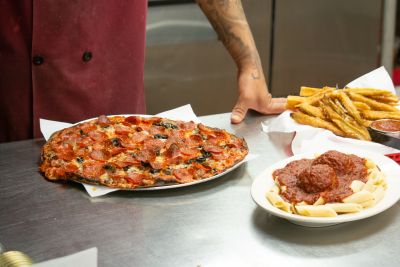Step through the door at Zaffiro's Pizza at 1724 North Farwell Avenue in Milwaukee, and you'll find yourself immersed in the past while perfumed by the scents of garlic, tomato sauce, fried seafood, and freshly made pizzas. It's a classic 1950s pizza joint with red-and-white checkered cloths draped over tables with salt, pepper, and Parmesan shakers.
Set in the Brady Street neighborhood—one of Milwaukee's three historic Italian enclaves—the restaurant has been family-owned for 71 years. Its story began with Librorio "Bobby" and John Zaffiro, whose parents arrived in the United States in 1913 from Santo Stefano di Camastra, Sicily.
The brothers opened Rock-a-Bye Tap in 1951, just a few years after the end of World War II, when American soldiers returned from Italy with newfound cravings for pizza. The bar was located in another historically Italian neighborhood, the Third Ward, which was hungry for familiar cuisine. So, the Zaffiros decided to start serving pizza.
As Italian food grew in popularity, so did the Zaffiros' business. Bobby opened Zaffiro's Restaurant on Farwell in 1954. It had just a few tables and a service bar. Bobby used his mother-in-law's recipes to prepare pasta dishes and lasagne. But the star of the menu was his super-thin crust pizza.
By 1970, it was clear Zaffiro's needed more space, so Bobby acquired the barber shop next door and added a dining room and a full bar. John made the pizzas while the more extroverted Bobby worked front of house. You could often find him making people laugh from behind the bar.
John retired in 1988, and Bobby passed away a year later. Bobby's wife, Rose, and their two sons, Mike and Joseph, took over Zaffiro's until Joseph left the business in 2007. Rose passed in 2008, and Mike and his family have held full ownership to this day.
The restaurant has weathered economic downturns, neighborhood shifts, and the COVID-19 pandemic, but for 71 years, it has remained standing, retaining its original decor and recipes. Sure, there have been changes, like its partnership with Marcus Theatres, which introduced regional theater-goers to the Zaffiro's brand, and expanded delivery service, which became necessary starting with the pandemic. But at the end of the day, Zaffiro's mission remains intact. It's all about building a community around good food.
Mike shared Zaffiro's history, business growth, challenges, and more.
Quite possibly the world's thinnest pizza crust
What inspired Zaffiro's super-thin pizza crust?
My father and my uncles took a road trip to New York, and they saw how big pizza was. At that time, there might have been one pizza place in Milwaukee. My dad said, "I'm going to put pizza on the menu at the bar."
He worked tirelessly to figure out how to make our crust, which is the thinnest crust in the world. It was through a lot of trial and error.
He wanted thin and didn't want it to droop. My dad always said about the pizza they tried out East, "Some of those pizzas are falling down."
They serve in eight slices with mostly triangular cuts. We do 16 with square-cut slices. It's known in Chicago as "tavern pizza."
Why has it been so important to preserve the original recipes?
It comes down to this: When I'm behind the bar, and someone comes in and hasn't been in here for 20 or 30 years and says, "It tastes the same," that's what I want. My father really stressed that you don't mess with the recipe.
Tell us about your partnership with Marcus Theaters and how that came about.
They came to me in 2008 and asked if I was interested. At that time, I was looking to open another place, but I decided to take the jump. They know what they're doing and have been terrific with us.
They do everything. It's a licensing agreement, so I don't have to worry about anything. They've got my name and my recipe. They were selling our pizza at Miller Park for three years.
They sell our pizzas in their theaters throughout the Midwest. They have three regular sit-down restaurants, and then in all the other theaters, they have it so you can bring your pizza into the theater with you.
What challenges have you faced?
The recessions over the years and 9/11 really hit us. All you can do is keep plugging away. Thank God we were able to stay in business and make enough to keep it afloat.
During COVID, we had to close the dining area. We had been delivering to downtown businesses during the day and decided to start delivery from the evenings until closing time to keep the business alive. We now deliver during all opening hours, and it's a big part of our business.
Mike Zaffiro worked behind the bar crafting Wisconsin Old-Fashioneds and more for decades.
How has your location on Farwell, near Brady Street, benefited you?
I've always wondered how it would have worked if we were somewhere else. When people say "Location, location, location," I believe that. We have location, location, location, but with a terrific product. You can have the location, but it's no good if you don't have a product that goes with it.
We've been in the community for a long time. With the area's apartments, you have turnovers. So people will be there for three years, and then you don't see them for a couple of years, and then all of a sudden they're coming in with kids. And they keep coming back.
Rebecca, Mike, Rose, and Michael Zaffiro
What is the future of Zaffiro's?
Both of my kids are working here, so they're the next generation. That'll be the third generation.
The restaurant hasn't changed much since we've been here. We've often thought about remodeling, but customers say, "Don't do that." And I agree with them.
Take your pick from deep-fried appetizers and old-school pasta to sandwiches and, of course, pizza.
What do you hope to share with customers?
We'll just keep continually giving them a good product and good service at a reasonable price. I think we're Milwaukee's oldest pizza place now. We've gotten great press throughout the years, but it all comes back to the quality of the food.
If you enjoyed this article, consider subscribing to my newsletter for more content and updates!







